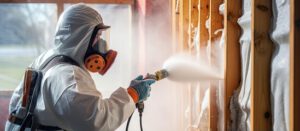Spray Foam Installation In The Attic And Wall Cavities
Spray foam is sprayed on walls in new construction or during a complete renovation. It’s a great option for existing homes because it can be installed in the wall and rafter cavities without tearing down the wall.
Efficiency hands out rebates for green weatherization projects that include spray foam. However, there’s a shortage of qualified experts and contractors. Contact Ultimate Radiant Barrier right now to talk to an expert.
 Insulation On The Ceiling
Insulation On The Ceiling
When insulating the ceiling, be sure to bag up light fixtures before spraying. You may also want to check your local building codes, which require a minimum gap between the ceiling and a light fixture.
Then, cover the area with a sheet and tape to prevent any overspray. Make sure that you’re wearing protective clothing and a respirator, and follow all application instructions carefully. The curing time can take up to 24 hours, so be patient! If you’re unsure about the quality of your work, ask a professional to inspect it.
Most modern homes lack proper insulation, and the resulting energy inefficiency leads to high utility bills. Adding spray foam to your home can dramatically cut your heating and cooling costs, so it’s a great investment. In addition, homeowners who upgrade their homes to be more energy-efficient often receive rebates or tax credits from the government.
Spray foam can be used to fill crawlspaces, insulate lofts, and even wrap around intricate pipework. However, this type of insulation is best left to professionals. Some insulation manufacturers only sell their products to trained technicians, and it’s often difficult for an enthusiastic DIYer to get the materials needed for a project at home.
While there are several benefits to insulating your home with spray foam, it is important to hire a qualified contractor. Many untrained contractors are pitching the product to unsuspecting homeowners as a cheap, quick, and eco-friendly way to reduce their heating bills, without disclosing its risks. Poorly applied spray foam can lead to extensive moisture damage, rotted framing, and toxic mold, requiring costly remediation and repair.
In an attempt to combat these issues, there is a recently published new inspection framework for surveyors on spray foam insulation. It aims to raise awareness of the dangers of this product and advises property owners to seek advice from an independent professional before deciding whether to use it in their homes. The guide also emphasizes the importance of record keeping, to help future property buyers and remortgage lenders understand the impact of a poor installation on a home’s value and condition.
Insulation On The Floor
Often overlooked floor insulation is one of the best ways to stop cold floors and draughts in older houses. Spray foam on the floor is a popular choice that helps target heat loss at this level and makes for a highly effective air barrier. This prevents cold air and warm air from mixing in the house and reduces energy costs and comfort.
This type of floor insulation is especially useful in pier-and-beam homes, rooms over garages, and other types of existing structures where the building envelope isn’t as tight as it could be. Foam insulation under the floor also works well in new construction, as it fills the spaces between the joists and creates a more airtight building envelope.
It’s important to wear gloves and other protective clothing during the spray foam installation process. Foam insulation is caustic before it dries, and you’ll want to avoid getting it on your skin. In addition, isocyanates are used in the spray foam formulation, and these chemicals can irritate your lungs. They’re especially hazardous for children, pregnant women, and people with asthma.
During spray foam installation, it’s important to drill two holes in each stud cavity. This is to ensure that there are no gaps where air can pass through and it is a good idea to follow the insulation manufacturer’s instructions for this exact hole placement. Once the foam dries, it creates a strong and durable barrier that will block moisture from passing into the wall.
When it comes to insulating existing walls, foam is a better option than drywall because it can be sprayed into the cavities between studs without removing any of the drywall. However, this is still a labor-intensive project that requires a lot of work and can be very costly.
While it’s tempting to use the cheapest insulation options, like fiberglass batts, for your home, the truth is that they can be very expensive in the long run. In addition, fiberglass batts can lose their insulating power over time, which means that you’ll end up paying more in energy bills over the lifetime of your home.
Insulation In The Walls
Aside from the attic, spray foam insulation can also be sprayed in wall cavities during new construction or renovation. If you’re doing a full gut job that requires removing the walls, this is one of the best ways to insulate a home without spending a fortune. The cost of having insulation sprayed in the walls varies, but you can typically expect to pay $1,284 to $3,741 per 1,000 square feet. The price will vary depending on the type of spray foam insulation you choose and the area of your home.
Unlike traditional fiberglass insulation, spray foam is a polyurethane-type product that expands to fill the space between the studs. It can also seal the edges of a frame, preventing air leakage and increasing energy efficiency. It also acts as a vapor barrier, keeping moisture from migrating into the structure and reducing mold growth. A home’s air leakage can make it hard to heat or cool. A drafty house is expensive to heat and cool, and the high humidity can cause wood rot and damage electrical wiring.
Business has been good for the past couple of years for the mold remediation company. He attributes the uptick in calls to homeowners tightening their homes, particularly with spray foam.
But while spray foam can save you money on your energy bills, it is not the most eco-friendly option for insulating your home. The foam is made from petroleum-based products and it contains the chemical methylene diphenyl diisocyanate, or MDI, which emits toxic gases during its production. These chemicals are known carcinogens, bio-accumulative toxicants, and endocrine disruptors. Exposure to MDI can also lead to chemical sensitivities that can develop after repeated exposure.
While spray foam is not the most eco-friendly choice, there are alternatives with lower embodied carbon. Some manufacturers offer spray foam containing low GWP blowing agents, such as HFOs, that are less toxic.
If you decide to opt for spray foam, consider working with a top-rated pro who can use a more sustainable product. They can also provide you with estimates for the total project cost. They can also advise you on other green building techniques and help you save even more on your energy costs.
Insulation In The Attic
When spray foam is applied to the attic, it seals the attic space and prevents conditioned air from leaking out of the house. This will keep the home warmer in winter and cooler in summer. It will also help to reduce energy costs and reduce the amount of heat that escapes through the attic.
Before the attic insulation is installed, it is important to make sure there are no leaks in the roof or ventilation system. Without proper attic ventilation, the attic can overheat, causing mold and water damage to the drywall. The attic should be inspected by a professional to ensure that there are no leaks and that the ventilation system is functioning properly.
Ideally, the attic should be insulated with open-cell foam. This type of insulation has an R-value of 3.5 to 3.8 per inch and is very affordable, at around $1.85 per square foot. Rigid foam boards or batts can be installed in the attic as well, but they will not have as high of an R-value.
Spray foam is a good choice for walls because it can be easily applied to the surface of the studs. It can also fill in crevices and voids and is effective at blocking air leaks. The foam is available in a variety of colors to match the existing wall color.
It is important to have the walls inspected by a home inspector before installing spray foam, as the existing drywall may need to be replaced. In addition, there are many different types of insulation for walls. The experts can recommend a contractor who is qualified to install the correct insulation in your home.
If you are considering having spray foam insulating your home, make sure the contractors wear appropriate personal protective equipment. They should also wear a dust mask to avoid breathing in the particles that are released during the spraying process.
Spray foam insulation is a great option for homes that need to be energy efficient, but it can create problems when it is not installed properly. There are very few consumer protection laws that regulate the spray foam industry, so homeowners who discover shoddy workmanship after a project has been completed have little recourse. Industry representatives like to say that less than one-tenth of 1% of spray foam installations fail, but this is based on informal surveys of installers and manufacturers.
